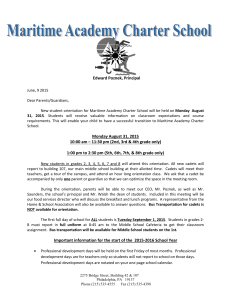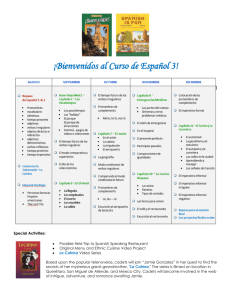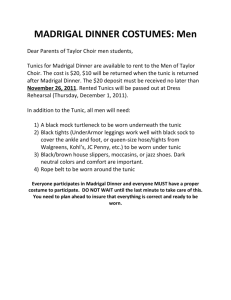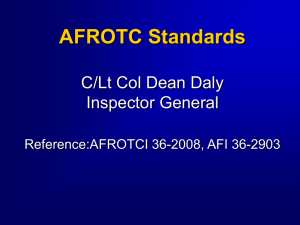Introduction
advertisement
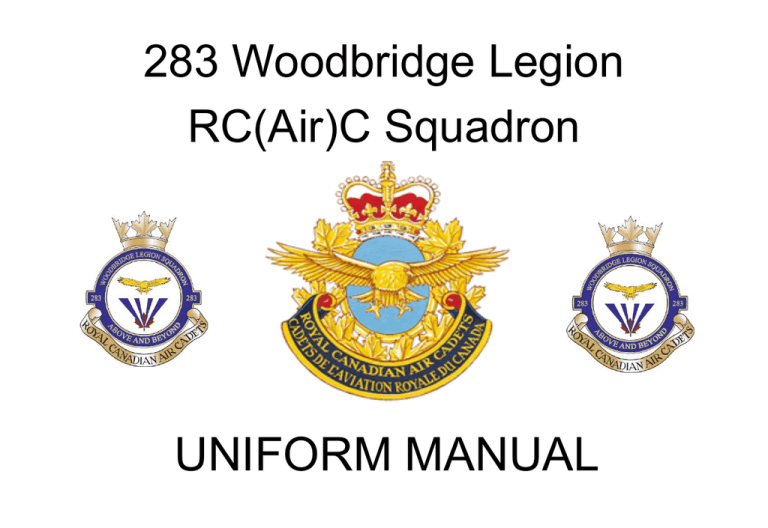
283 Woodbridge Legion RC(Air)C Squadron UNIFORM MANUAL Introduction Drill and Uniform share a lot of similarities. Like drill, perfect uniforms do not happen magically overnight. They come with determination, practice, and hard work. And of course, in order to achieve perfection, you need the knowledge to do so. While knowledge and skill will come over time, it cannot hurt to learn a few tips and trick. The purpose of this booklet is to instruct cadets on proper uniform techniques and standards. With a proper understanding and lots of hard work, soon you too will be as sharp as your Warrant Officers. Wedge • • • • • To be worn in the centre of your forehead, tilted to the right. The front edge of the wedge should be approximately 2.5 cm above your right eyebrow. (Approximately the width of two fingers) Two Air Force buttons must be attached in pre-cut holes at the front; birds 'flying up' Wedge Insignia (Brass) is worn on the left side of wedge. Center of badge is positioned mid-way between the front half of the wedge. Hair (Males) • • • • • • • • • • Trimmed at the back, sides, and will not touch the ears. Should be a distance of 2.5 cm above the shirt collar. Should be no more than 15 cm in length. When wedge is removed, no hair shall touch the ears or fall below the top of eyebrows. Unnatural colors are not permitted. Sideburns shall pass the ear, and shall be squared off horizontally. Moustaches (Fully grown) shall be neatly trimmed, and should not extend below the corners of the mouth. They are not to be greater than two cm in bulk. Beards are only permitted if cadets are of the Sikh religion, or if cadets are experiencing problems preventing them from shaving. In the latter case, a note from a doctor or parent is required. Hair (Females) • • • • • • • The most standard hairstyle is for hair to be tied back, and in a bun, complete with a hairnet. Bobbie pins and beret clips may be used. Hair ties and hair nets must match the natural color of the cadets’ hair Hair will not be in exaggerated styles, or unnaturally colored. Multiple braids and/or cornrows shall be directed toward the back of the head, and gathered in a bun. Hair that is too short to be tied in a bun shall be as neatly groomed as possible, and will not extend past the top of the collar. Hair will be gelled back, to prevent ‘whispies’ and loose hairs. Makeup and Jewelry • • • • • • The only jewelry that may be worn in uniform shall be a wristwatch, a medical alert bracelet, and a maximum of two rings. Only females are allowed to wear earrings. They may wear a single pair of gold, silver, or white pearl earrings in pierced ears. The single stud earring, worn in the center of each earlobe, shall be spherical in shape and will not exceed 0.6 cm in diameter. Covering unauthorized piercings with a band-aid is not acceptable. Religious jewelry may be worn, but must not interfere with dress regulations. How to Iron • Things You’ll Need; – An Iron, of course. – An ironing board or hard, flat and clean surface. – A damp pressing cloth (Towel, pillowcase, t shirt etc.) • • • Ensure your iron is at an effective, but safe heat. Remember that steam plays an important part in getting the sharpest creases. Depending on the piece of uniform, fold in a way so that you will get the creases you aim for. It is wise to use a damp pressing cloth, so your uniform will not burn. Press hard, and hold for a few seconds so that the heat will set in, leaving you with sharp creases. • • Shirt T - Shirt • • • Cadets who are not NCOs are to wear the issued blue t-shirt. The shirt will be tucked in, washed, and free of creases. (Wrinkle free) On COs Parades, or other events, cadets may be require to wear their blue dress shirt with a tie. Dress Shirt • The blue dress shirt will be washed, ironed, and wrinkle free. • The only creases in the shirt shall be down the centre of each arm, beginning at the centre of each epaulette. • When wearing a tie, it tie should be neatly centered and lint free. Tie Your necktie should be clean and lint free. The knot should be compact and done up to the collar when worn. There are two methods of tying a necktie. WINDSOR KNOT FOUR-IN-HAND-KNOT Tunic • • • • • • • • • • Make sure tunic is stain and lint free. This means washing your tunic, and de-linting with a lint brush. Tunic must be pressed and ironed, but will have NO CREASES. Ensure all buttons are buttoned. To prevent pocket flaps from curling, lay them against the ironing board and individually go over them with the iron. Be sure that your tunic belt is centered, and does not twist or curl. Ensure it goes through each belt loop. Excess material will be held in by a floating belt loop, and should not exceed 8 cm. If it is too long, the belt is to be adjusted, or a new one must be issued from supply. Nothing is to be kept in the pockets of your tunic. Badges • • • • • • • Shoulder Flash – Worn on both sleeves of tunic, placed 2 cm below the shoulder seam. Rank Badge – Centered half-way between the shoulder seam and elbow. Badges should be parallel to the ground when proving. Proficiency Badge – Centered on the left tunic sleeve, beginning at the top of the bottom cuff. Name tag – Worn centered above the flap of the right breast pocket. Camp Badges – Placed on the right sleeve. The first badge will be placed centered, the second, flush in front of it, and the third, behind the centered badge. There will be no more than three in a row. Fitness / Range Qualifications – If received, they mirror camp badges but are placed on the left tunic sleeve. Proficiency level badges are placed one cm above. First Aid Badges - Centered on the right sleeve, one cm above camp badges. All badges should be sewn on tightly, hiding the threading as much as possible. The color of the thread should match the color of the badge. (See illustrations on next page for reference) Placement of Badges Black-web Belt and Grey Socks • Belt • Adjust belt so that the brass is in line with the edge of the buckle. (Brass on Brass) • Cadets are also permitted to purchase and wear belts with a squadron buckle. • Socks • Cadets are to wear issued grey wool socks • If allergic, cadets are permitted to wear black or grey nylon or cotton socks • Tip: Wear a pair of thin socks under your wool socks to prevent itchiness. Pants • • • • • • Must be clean, ironed and well pressed with proper creases. Creases go on the front and back of the legs, and no where else. Creases go up the front centre of each leg, up to the waist, meeting the two front belt loops. Back creases go up the centre of the pant leg and meet together at the rear belt loop, to form an upside down ‘V’ shape. Pants are to be hemmed accordingly, and should end in between the second and third shoe lace. Beware of ‘train tracks’ (Multiple creases) Boots • • • • • • Perhaps the most tedious part of your uniform, polishing your boots takes time and dedication. Things You’ll Need: • Black Kiwi Polish • A kiwi cloth • Water • Toothbrush (For welts) First remove dust and dirt using a soft damp cloth (Not your kiwi cloth) Use a toothbrush with black polish to blacken welts (The rubber part that isn’t the toe.) Apply a moderate amount of polish to the area of the boot you wish to polish first. Use a kiwi cloth, wrapped around your finger and dipped in cool water. Begin to apply polish in a circular motion, beginning with large circles and narrowing in. Continue the circular motion till the polish disappears and a faint shine begins to show. You will have to continue applying coats of polish until your boots produce a high gloss. As time progresses, you will become better and so will your boots. Remember: • Many rumors and short cuts fly around between cadets. • Remember that there are no short cuts to doing your boots, and the most effective way is the proper way. • Only use black polish, and not neutral or ‘parade gloss’ • Liquid polish looks good for about fifteen minutes. Then it dries, and cracks, and leaves you quite embarrassed. • Do not burn, freeze, use Vaseline, or apply any other crazy technique you’ve heard. • Use everything in moderation. Polish and water, in the right measurements, are key to a high shine. Lacing Your Boots Boots are to be laced horizontally, in a straight across method. They should go through every hole, reaching the top. Conclusion Ultimately, a good uniform is not a hard task. Yes, it requires patience and practice. Yes, it will take time. But no, it is not hard. Now that you’ve got the knowledge, it’s time to apply it. The way you carry yourself, through drill, uniform, and attitude shows who you are as a cadet. Remember that nobody is born a perfect cadet, and you are bound to make mistakes. But also remember that cadets is not an experience for one person alone. Your flight and your squadron are your team, and they are there to help you. Don’t be afraid to ask an NCO for help and advice. Remember that they were once little cadets too. Sources and Credit • • Created and Edited by Illustrations and Information taken from; – CATO 55-04 Air Cadet Dress Instructions – CATO 55-04 Annex F; Illustrated References – RC(AIR)C Level One Handbook
